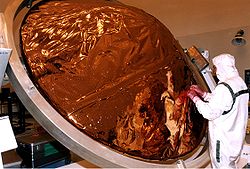Thermal insulation
# Insulation
**Insulation** is the process of preventing the transfer of heat, sound, or electricity from one area to another. It is commonly used in various applications, including building construction, electrical engineering, and industrial processes, to enhance energy efficiency, safety, and comfort.
## Types of Insulation
### Thermal Insulation
Thermal insulation reduces heat transfer between objects in thermal contact or within the range of radiative influence. It is essential in building construction to maintain desired temperatures and improve energy efficiency. Common materials used for thermal insulation include fiberglass, foam, and cellulose.
#### Applications
- **Buildings**: Walls, roofs, floors
- **Pipes and Ducts**: Hot water pipes, HVAC ducts
- **Appliances**: Refrigerators, ovens
### Acoustic Insulation
Acoustic insulation minimizes the transmission of sound between different spaces. It is used in buildings, vehicles, and industrial settings to reduce noise pollution and improve sound quality.
#### Applications
- **Buildings**: Walls, ceilings, floors
- **Automobiles**: Engine compartments, cabins
- **Industrial Equipment**: Machinery enclosures
### Electrical Insulation
Electrical insulation prevents the unwanted flow of current between conductors and protects against electric shocks. Materials with high resistivity, such as rubber, glass, and certain plastics, are commonly used for electrical insulation.
#### Applications
- **Cables and Wires**: Insulating layers around conductors
- **Electrical Devices**: Insulation in motors, transformers
- **Safety Equipment**: Insulating gloves, mats
## Insulation Materials
### Fiberglass
Fiberglass is made from fine strands of glass and is widely used for thermal and acoustic insulation. It is lightweight, non-combustible, and has good thermal performance.
### Foam
Foam insulation, such as polystyrene and polyurethane, offers excellent thermal resistance and is used in a variety of applications, including building insulation and packaging.
### Cellulose
Cellulose insulation is made from recycled paper products and treated with fire-retardant chemicals. It is an eco-friendly option for thermal and acoustic insulation in buildings.
### Mineral Wool
Mineral wool, including rock wool and slag wool, is produced from molten rock or industrial waste. It is known for its fire resistance and sound absorption properties.
## Benefits of Insulation
- **Energy Efficiency**: Reduces energy consumption by maintaining desired temperatures.
- **Comfort**: Enhances indoor comfort by regulating temperature and reducing noise.
- **Safety**: Provides fire resistance and protects against electric shocks.
- **Environmental Impact**: Decreases carbon footprint by lowering energy use.
Insulation is a crucial component in various fields, offering numerous benefits such as energy efficiency, comfort, and safety. By selecting appropriate insulation materials and methods, significant improvements in thermal, acoustic, and electrical performance can be achieved.
Thermal Insulation Media
Mineral wool insulation, 1600 dpi scan
Thermal insulation on the Huygens probe
Cabin insulation of a Boeing 747-8 airliner





